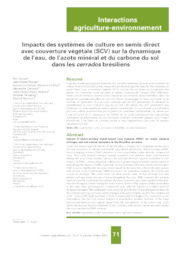Impacts des systèmes de culture en semis direct avec couverture végétale (SCV) sur la dynamique de l'eau, de l'azote minéral et du carbone du sol dans les cerrados brésiliens.
Impacts des systèmes de culture en semis direct avec couverture végétale (SCV) sur la dynamique de l'eau, de l'azote minéral et du carbone du sol dans les cerrados brésiliens.
Author(s): SCOPEL, E.; DOUZET, J. M.; SILVA, F. A. M. da; CARDOSO, A.; MOREIRA, J. A. A.; FINDELING, A.; BERNOUX, M.
Summary: Under the humid tropical climate of the Brazilian cerrados, new cropping systems have become necessary to ensure sustainable agricultural production. Direct-sowing mulch-based cropping systems (DMC) introduce a cover crop before or just after the commercial crop. They help farmers enhance natural resources and produce more total biomass during the year. Crop residues protect the soil and increase organic restitution to the system. In 1999, a Franco-Brazilian collaborative project began scientific studies aimed at quantifying the impact of DMC, especially on the dynamics of water, carbon and nitrogen. DMC systems significantly decrease water runoff. In this way they effectively fight against soil erosion, even if additional infiltrated water can sometimes saturate the system and escape by drainage. The cover crop can then recycle some of that drainage loss and protect and use water resources better throughout the year. DMC systems also provide more favourable conditions that ensure the more intensive and more regular mineralisation of soil organic matter during the rainy season. Some of the organic mulch mineralises at the same time, providing the commercial crop with the benefit of a higher pool of inorganic nitrogen. The additional cover crop can recycle part of the nitrogen not used by the commercial crop and some of the nitrogen mineralised before or after this commercial cycle. Under DMC high microbial activity is responsible for higher CO2 emissions to the atmosphere, but the soil carbon balance is nonetheless positive because of the large biomass production and organic input from the introduction of the cover crop. Even under the hot and humid conditions of the cerrados, soil carbon content increases under the more productive DMC systems.
Publication year: 2005
Types of publication: Journal article
Unit: Embrapa Rice & Beans
Keywords: Agronomia, Biomassa, Cerrado, Matéria Orgânica, Planta de Cobertura, Plantio Direto, Recurso Natural, Solo
Observation
Some of Embrapa's publications are published as ePub files. To read them, use or download one of the following free software options to your computer or mobile device. Android: Google Play Books; IOS: iBooks; Windows and Linux: Calibre.
Access other publications
Access the Agricultural Research Database (BDPA) to consult Embrapa's full library collection and records.
Visit Embrapa Bookstore to purchase books and other publications sold by Embrapa.

